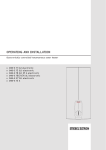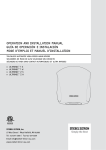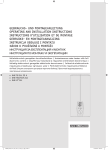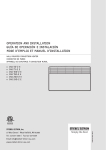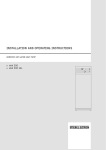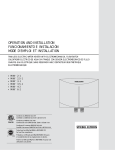Download INSTALLATION AND OPERATING INSTRUCTIONS
Transcript
Installation and operating instructions Domestic hot water heat pump »» wwk 300 »» WWK 300 SOL ECO ON °C OFF 1x >60°C Index Page Specification Operating instructions - for users 1 Operation and control 1.1 Equipment description 1.2 Correct operation 1.3 Incorrect operation 1.4 Description of functions 1.5 Operation outside the scope of applications 1.6 Maintenance and cleaning 1.7 Operation and control 1.8 Troubleshooting by users 3 3 3 3 3 3 3 4 4 Installation instructions - for contractors 2 Safety equipment and maintenance 5 2.1 On the equipment 5 2.2 On the system 5 3 Installation 6 3.1 Transport 6 3.2 Positioning 6 3.3 Water connection 6 3.4 Boiler connection 7 3.5 Electrical connection 8 4 Commissioning 9 5 Shutting the equipment down 9 Guarantee 10 Environment and recycling 10 Information for owners Keep these operating instructions safely and pass them on to any new user, should the equipment change hands. Let your contractor check their content in conjunction with any maintenance or repair work. Positioning, installation and commissioning must be carried out by trained contractors, in accordance with these operating and installation instructions. The manufacturer’s warranty only applies, if the WWK 300 is installed, connected and operated in accordance with these operating and installation instructions. In conjunction with the positioning/ installation, observe all local/national standards and requirements, as well as the stipulations by your local water board and energy supply company. Risk of injury Where children or persons with limited physical, sensory or mental capabilities are to be allowed to control this appliance, ensure that this will only happen under supervision or after appropriate instructions by a person responsible for their safety. Children should be supervised to ensure that they do not play with the appliance. 2 WWK 300 074361 WWK 300 SOL 074362 kW 1,6 1,6 kW kW 1,5 0,5 1,5 0,5 4,2 4,2 dB(A) dB(A) 45 60 45 60 m² m³ 6 13 6 13 °C °C l MPa m² 65 55 303 0,6 65 55 284 0,6 1,3 kWh 0,74 0,85 A V C 16 230 1/N/PE 50 440 1940 C 16 230 1/N/PE 50 440 1940 IP21 R134a IP21 R134a mm mm mm mm mm 1792 660 690 1920 2050 1792 660 690 1920 2060 kg kg 157 460 180 464 mm 20 G 1/2 (male) 22 mm 20 G1 G 1/2 (male) 22 mm 6 35 550 0,850 6 35 550 0,850 2 Outputs Heating output L15/F70/W55 Power consumptions Power consumption - booster heater Power consumption L15/F70/W55 Coefficients of performance Coefficient of performance L15/F70/W55 Sound data Sound pressure level at 1 m distance in a free field Sound power level (EN 12102) Application limits Min. installation room floor area Min. installation room volume Hydraulic data Max. DHW temperature HP DHW temperature Cylinder capacity Permissible operating pressure - DHW Surface, indirect coil Energy data Standby energy consumption/24 h Electrical details Fuses Rated voltage Phases Frequency Power consumption Max. power consumption Rated current Versions IP-Rating Refrigerant Dimensions Height Width Depth Height of unit when tilted Height when tilted incl. packaging Weights Weight (dry) Weight (wet) Connections Condensate drain Heat exchanger connection DHW circulation connection Water connection Values Lower air temperature limit Upper air temperature limit Air flow rate Refrigerant capacity Hz W W mA °C °C m³/h kg The specifications apply to appliances without an air duct connection. As long as the air flow rate is not reduced by more than 10 %, the heat-up time will not increase. In the case of an air supply via an air duct, the required air flow rate is assured if the connected air duct, with a diameter of 200 mm, is not longer than 4 m. ! Only connect the air duct to the air inlet side of the appliance. Prevent additional pressure drops caused by diverters or the installation of grilles and filters. Operating instructions for users and contractors 1 Operation and control The WWK 300 domestic hot water (DHW) heat pump from STIEBEL ELTRON is an automatic DHW heater offering a capacity of approx. 300 l. The required DHW temperature can be preselected. Your local contractor will install, connect and commission your WWK. Nevertheless, you should familiarise yourself with the most important aspects of this equipment. 1.1 Equipment description The WWK 300 contains two heat sources within the cylinder; both heat the water to the required temperature: – Heat pump – Electrical supplementary heater The WWK 300, with suffix SOL, not only contains a heat pump and an electrical supplementary heater, but also a heat exchanger permanently fitted inside the cylinder, which can be supplied with energy from a boiler or solar heating system. The WWK 300 extracts energy from the air which can be utilised to heat the water contained inside the cylinder. This energy extraction leads to a cooling of the installation room by approx. 1-3 °C. The WWK can also be operated with a connection to an air duct. However, such air channels must not be smaller than Ø 200 mm; their length should not exceed a maximum of approx. 4 m. The WWK 300 also extracts moisture from the air, which turns into condensate and must be drained off. A hose connection is provided for that purpose. Additionally Order.-No. Description PK 10 229286 Condensate pump Air channel 071448 For connection to adaptor air hoses / channels 200 mm dia. (circular) 1.2 Correct operation The appliance is intended for domestic use, i.e. it can be used safely by untrained persons. The appliance can also be used in a non-domestic environment, e.g. in a small business, as long as it is used in the same way. This DHW heat pump is designed to extract energy from the air inside the equipment installation room or from a room, to the ambient air of which it is connected, via air ducts. With that energy it heats domestic hot water (DHW). 1.3 Incorrect operation Never – use greasy exhaust air – heat liquids other than potable water – install the equipment a) outside b) in rooms at risk from frost c) in rooms at risk from dust, gases or vapours liable to explode – operate the equipment with an empty cylinder – operate the integral heat exchanger inside the equipment cylinder with liquids other than heating water. 1.4 Description of functions 1.4.1 Heat pump operation This is the standard operating mode, to which the limits of scope of the heat pump apply (see: specification). To heat the cylinder content of approx. 300 litres of water to 55 °C, the WWK 300 (to EN 255 part 3) requires: ϑ Space H rel ϑ Cold water τ Heat-up COP(t) 6 °C 15 °C 35 °C 70 % 70 % 47 % 15 °C 15 °C 15 °C 11.5 h 9.0 h 6.4 h 3.3 4.2 5.2 The water inside the cylinder will be heated to 55 °C by the electrical supplementary heater, which is controlled by the programmable time switch, subject to the heating period being long enough. This enables the option of making greater mixing water volumes available at certain times. At all other times, the water will be heated to the temperature selected on the controller (see page 4, Fig. 1, item 3). If the heat pump was manually switched OFF and ON again after a power failure, the compressor will only re-start (after approx. 15 minutes) when the pressure inside the refrigerant circuit has normalised again. ! Press the push button only once if you want to activate the electrical supplementary heater only to cover a peak demand. 1.4.3 Boiler operation via heat exchanger (only for SOL version) A heat exchanger, which is generally connected to a central heating system, is integrated into the cylinder. Subject to the heating water flow temperature, the entire cylinder capacity should be heated up by the heat exchanger in between 3 and 4 hours. 1.5 Operation outside the limits of use below 6 °C to 4 °C Subject to the relative humidity and the DHW temperature inside the cylinder, the evaporator begins to ice up below a room temperature of 6 °C. When the evaporator is covered in hoarfrost, the frost stat N2 (see wiring diagram) shuts down the compressor, whilst the fan continues to operate, thereby defrosting the compressor. The compressor starts again automatically after the defrosting process has been completed, and the heat pump operation continues. The minimum temperature required for the heat pump operation is +4 °C. The evaporator is defrosted upon demand at operating temperatures between +4 and +6 °C. This increases the heat-up time. Room temperature higher than 35 °C The heat pump will be switched OFF by safety equipment at room temperatures above approx. 35 °C. The heat pump will be restarted automatically after a brief cooling down period. The heat pump will be switched OFF again if the room temperature is still higher than 35 °C. Take appropriate steps to prevent the ambient temperature rising above 35 °C. ! 1.4.2 Electrical supplementary heater You can accelerate the heating-up process with the electrical supplementary heater, if the DHW demand increases or if the WWK 300 has previously been switched OFF and you require hot water as quickly as possible. For reasons of saving energy, the electrical supplementary heater only heats the top third of the cylinder capacity (approx. 100 litres). This takes approx. 2 hours. In SOL versions, approx. 50 litres are heated up due to the flange being positioned higher up on the cylinder. The electrical supplementary heater is switched ON when the actual temperature falls below 58 °C and is switched OFF when 65 °C are exceeded. 1.6 Maintenance and cleaning The WWK 300 is largely maintenance free. Maintenance must only be carried out by qualified contractors. Have the protective anode checked regularly. Your contractor, who will be familiar with your local water quality, will advise you of the optimum timing for such maintenance. The first inspection of the protective anode is due after two years. 3 1.7 Operation 1.7.1 Overview of the user interface Description in brackets, see wiring diagram Fig. 8, page 8 1 (S1) 4 (S5) 2 (S2 / H1) C26_03_01_0312 3 (N1) Abb. 1 Function WWK 300 / WWK 300 SOL Only heat pump operation 25 °C to 55 °C. Single reheating via the electrical heater rod to 65 °C. Programmed start of the electrical heater rod via the time switch. 1.7.2 Description of functions – Switch (1) switches the entire heat pump ON (I) or OFF (0). – Using push button (2), you can activate a single quick heat-up of the cylinder via the electrical supplementary heater. After the top third of the cylinder capacity has reached a DHW temperature of 65 °C, the electrical supplementary heater is switched OFF, but is not automatically switched ON again. – An indicator lamp is integrated into push button (2), which lights up when the electrical supplementary heater is switched ON. – Select the DHW temperature with the rotary selector (3) of the thermostat, Fully clockwise approx. 55 °C ECO approx. 40 °C (frost protect. stage) approx. 25 °C In position ECO, the heat pump operates more efficiently than at the r.h. end stop. You will need to establish the DHW temperature you require, because a higher temperature would result in a larger volume of DHW at approx. 40 °C (temperatures for baths and showers are generally around 40 °C). – The time switch (4) is equipped with a week disk comprising 84 switching 4 Main ON/OFF switch (1) ON ON ON Push button (2) Clock (4) programmed – 1x – – – Yes segments. The shortest switching period is 2 hours long. Segments pressed inwards towards the disk centre (approx. 2 mm lift) are switched ON. – The DHW display sensor captures the DHW temperature inside the upper third of the cylinder (approx. 100 litres). 1.8 Troubleshooting by the user 1.8.1 No hot water Should you fail to obtain hot water at any time, you can take the following steps to remedy that situation. No electrical power Check the fuse/circuit breaker in your fuse box. If it has blown/tripped, replace/reset the fuse/ MCB. Notify your local contractor, if the MCB trips/fuse blows again when you insert the mains plug into the socket again. Still no hot water, even though power is available Check, whether the air inlet/outlet is unobstructed. The thermoswitch trips out or the high limit safety pressure limiter switches the compressor OFF if the compressor is overloaded due to excessive ambient temperature or excessive extract temperature (>35 °C), or because of a fault in the refrigerant circuit. Ask your local contractor to remove the relevant fault. The thermoswitch automatically switches itself ON again. The high limit safety pressure limiter must only be reset by your contractor after he has removed the cause of the relevant fault. ! 1.8.2 Other faults Safety valve of the cold water supply line drips This may occur during the heat-up phase and is completely normal. Condensate drain drips This always happens when the surface temperature of the evaporator is lower than the ambient dew point temperature. For all other faults, consult your contractor. DHW heating can be maintained in most fault conditions by switching the electrical supplementary heater ON. Installation instructions for contractors Pull the mains plug out its socket before commencing any work on the equipment. ! For operation with a second heat ! source, e.g. a solar thermal system, the maximum cylinder temperature must not exceed 65 °C. This must be ensured with an external control unit. 2.1 On the equipment In case of a fault, the safety equipment of the WWK 300 interrupts the relevant power circuit. Such faults can, for example, be cau! sed by a faulty DHW priority setting on a connected boiler. The protective anode is located behind the front fascia. When removing the fascia, please note that the earth strap to the fascia is not pulled off (Fig. 2b). If required, remove the strap from the push-on connector. When replacing the front facia ensure that the earth cable is correctly connected. ! Cleaning the evaporator Maintaining the full output of the WWK 300 requires an occasional professional cleaning of the evaporator. Your contractor will determine the timing for this operation. 2.2 On the system Safety valve (on-site provision) This valve opens when the water pressure exceeds the preset value of 6 bar, thereby High limit safety cut-out (STB) This will shut the equipment down if the DHW temperature exceeds 95 °C. Reset the high limit safety cut-out by pressing the reset button (item 2, Fig. 3), after the cause of the fault has been removed. For this, open the equipment as shown in Fig. 2a. Protective motor switch The protective motor switch will shut down the compressor if it is overloaded because of excessive thermal load. Remove the relevant fault. After a short while, the protective motor switch will restart the compressor automatically. Protective anode A protective anode is integrated into the DHW cylinder to protect it against corrosion. The protective anode is pushed through the flange from inside out and secured. For inspections, the flange will be removed to enable the simultaneous inspection of the electrode, the heater rod and the internal enamel coating. When replacing the anode, ensure a perfect contact with a metallic, conductive surface during assembly. The timing of the inspection is subject to the local water quality and is determined by your local contractor (Stiebel Eltron recommends that the first inspection takes place no later than after two years). Pressure reducing valve (on-site provision) Check the valve for perfect function. Replace it, if necessary. Regular valve maintenance Safety requires that valves are regularly checked for perfect function. How quickly limescale builds up depends on the local water quality. As your local contractor is familiar with your local water quality, let him determine the timing of this check. ON °C OFF >60°C 26_03_01_0313 1x Abb. 2a 26_03_01_0315 Safety high pressure limiter (SDBK) The safety high pressure limiter shuts down the compressor, if the pressure inside the refrigerant circuit exceeds the permissble maximum value. The safety high pressure limiter may also respond, if the WWK 300 is operated above its permissible limit (>35 °C exhaust temperature). Reset the safety high pressure limiter by pressing the reset button (item 1, Fig. 3), after the cause of the fault has been removed. For this, open the equipment as shown in Fig. 2a. ECO relieving the pressure. It is adjusted so that no water will be expelled when heating is switched OFF. Should it continue to drip excessively, either the valve seat has become contaminated, the water pressure is too high or the pressure reducing valve has become faulty. Abb. 2b 1 2 26_03_01_0009 2 Safety equipment and maintenance Abb. 3 5 3 Installation Positioning 688 100 C26_03_01_0314 Min. 2150 1800 Air Air Min. 400 The available floor area in the installation room must be at least 6 m². Never install this equipment in rooms with a volume of less than 13 m³. Never restrict the ambience around the WWK 300 through walls or ceilings closer than shown in Fig. 4. The room temperature must never fall below +6 °C, as the ambient temperature will be reduced by approx. 1-3 °C through the heat pump operation. The initial temperature level will be re-established approx. ½ hour after the heat pump has been switched OFF. 3.1 Transport To protect the equipment against damage, it must be transported vertically inside its dedicated packaging. Where space is restricted, you may also move the equipment tipped backwards at an angle. 660 Min. 400 3.2 Positioning 1. Unscrew the four screws from the nonreturnable pallet. 2. Remove the washers. 3. Before removing the equipment from the pallet, remove the anti-vibration mounts from the pack supplied with the equipment, and insert fully into the equipment. 4. Remove the equipment from its pallet and position it where required. 5. Level the equipment by manipulating the anti-vibration mounts. When installing the heat pump in a boiler room, ensure that the boiler will not be impaired. 3.3 DHW connection Observe the regulations imposed by your local water board. Install the cold water supply line in accordance with Fig. 5. Checking installation conditions The room where the WWK 300 is be installed must meet the following conditions: To facilitate an easy connection to the water system, the equipment will be supplied (in a separate pack) with angled plug-in fittings, pipe connectors with union nuts and flat gaskets. Fitting the plug-in connector (see page 9.) Stable floor (WWK 300 wet weight approx. 460 kg). Never operate the WWK 300 in rooms, at risk from explosion due to dust, gases or vapours. Include in your considerations the utilisation of waste heat, for example from a boiler, tumble drier or refrigerator/ freezer. Dimensions in mm Fig. 4 Connection dimensions To protect against the risk of corrosion, make the connection as flat packing seal. The use of hemp on connections is not acceptable. ! 159 1 2 3 4 5 3 15 9 2 6 7 8 9 10 11 12 13 14 16 6 22-40 adjustable 56 194 376 558 1055 12 1264 1438 4 7 1 15 16 5 8 10 11 12 13 14 Cold water supply Ø 22 mm DHW connection Ø 22 mm Condensate drain ½” - hose connection Circulation connection G ½ ½” nipple for collector or boiler sensor Heating water flow Ø 22 mm Heating water return Ø 22 mm Drain valve Safety valve Straight-through shut-off valve Test port for pressure gauge Non-return valve Test valve Pressure reducing valve (only in case of > 4.8 bar pressure) Electrical cable grommet DHW circulation pump 10 Fig. 5 6 C26_03_01_0315 32 Dimensions in mm We recommend the following combinations when using metal pipework for the installation: Cold water line DHW line Copper pipe Steel pipe Copper pipe Steel or copper pipe 3.4 Connection examples Reheat with solar collector Insulate the DHW line in accordance with local regulations. Please adhere to the order of fittings on the cold water side precisely (see Fig. 5). Prior to installation: Flush out the line. Install the safety valve into the cold water line. The expansion water must be able to be seen to drip into a basin or funnel. The diameter of the connecting pipe must not be larger than the safety valve diameter. Size the drain so that water can drain off, even if the safety valve has been fully opened. The outlet must not be able to be blocked/closed off. The safety valve must open at 6+1 bar. Install a drain valve at the lowest point of the cold water supply line. Install a pressure reduction valve when the water pressure is higher than 5 bar. Special measures are required at water pressure above 10 bar (see Fig. 5). Condensate drain The condensate from the WWK 300 is channelled to a drain via a hose (½” dia.). Where necessary, install a condensate pump (for part no., see page 3). C26_03_01_0016 DHW Cold water safety assembly Reheat with boiler Connecting a circulation line to the cylinder The heat losses incurred in the circulation line and the electrical power consumption of the circulation pump, reduce the efficiency of the system. The cooled down water in the circulation line mixes with the cylinder content. Where possible, avoid installing a circulation line. Where that is not possible, control the circulation pump thermally or by a time switch. C26_03_01_0010 DHW 3.4 Boiler connection (WWK 300 SOL) Pipe bends with union nuts are supplied with equipment which has heat exchangers installed, to enable easy connection to a boiler. Such connection is only permitted with boilers providing DHW priority and in conjunction with an electronic temperature sensor operating with low voltage (capturing the cylinder temperature of the heat pump). The sensor well is located on the front of the heat pump behind the lower door. The DHW temperature is adjusted at the boiler control unit. Cold water safety assembly 1 2 3 4 5 6 7 8 9 10 DHW heat pump DHW cylinder probe Solar circulation pump Safety valve Non-return valve Central heating circulation pump Mixer circuit circulation pump Expansion vessel Shut-off valve Fill & drain valve 11 12 13 14 15 16 17 18 19 Solar collector Boiler Air vent valve Collector sensor Outside temperature sensor Mixer valve probe Mixing valve Solar control unit Boiler control unit Fig. 6 7 3.5 Electrical connection The WWK 300 is supplied fully wired. A 230 V / 50 Hz socket is required. Line fuse rating: 16 A gL. Control panel WWK 300 / WWK 300 SOL A cable grommet is provided at the back of the heat pump to enable control equipment to be connected (temperature sensor). Before plugging in the mains plug, set switch (1) (Fig. 1) OFF (0). Fill the cylinder with water. X1 Z1 N2 K1 N3 C26_03_01_0017 ! Fig. 7 Wiring diagram WWK 300 / WWK 300 SOL X1 N 95°C +0/-6 F1 L1 S1 PE 21 11 22 12 N L 4B 1A 5B 2A 5 5 PE 6 25 - 55°C 1 N1 S5 4B S2 5B K1 E1 F1 F3 F4 H1 K1 M1 M2 N1 N2 N3 S1 S2 S5 X1 Z1 4 Electric heater rod High limit safety cut-out Pressure limiter Protective motor switch (Klixon) Indicator lamp -- electric heater (S2) Relay Compressor Fan Heat pump controller Hoarfrost temperature monitor 65 °C limiter Main ON/OFF switch Push button “E heater rod 1x” Week time switch Mains supply Capacitor 2 1 1 3 2 5 11 2 -7°C / +3°C 3 N2 4 2 12 9 9 1 20.4 bar 1 65°C / 60°C N3 F3 P 2 4 2 Z1 13 4 14 10 S/A A 3A B 15 Fig. 8 8 H1 6B 8 M2 M1 15 M 1 F4 8 8 C 8 C26_03_01_0011 E1 K1 R/P 4 Commissioning Your local contractor must implement the commissioning: Fill the cylinder to prevent damage to the compressor and radiators. For filling, open the water valve, until water flows out. Open the safety valve, until water flows out free of bubbles. Then close the safety valve. – Starting the WWK 300: Set switch 1 to ON. – Supplementary heater: Press push button 2; the indicator lamp inside the push button lights up – Set the temperature selector 3 Fully clockwise. – Set the time at clock 4. Inform the user that water may drip from the safety valve whilst the water is being heated up. 5 Shutting the equipment down Puul the mains plug for reasons of frost protection and good hygiene, drain the cylinder if it is taken out of use for longer periods Fitting the plug-in connector The plug-in connectors are equipped with a retainer with stainless steel serrations and an O-ring for sealing. In addition, they are designed with the "Twist and secure" function. By simply turning the screw cap manually, the pipe is secured in the connector, and the O-ring is pushed against the pipe to seal it. Gap between the screw cap and the casing (released position) Making the connection The fitting must be in its released state before inserting the pipe. In this position, there is a small gap between the screw cap and fitting body. Push the pipe past the O-ring until it bottoms out inside the connector. Tighten the screw cap unit it meets the casing. This presses the O-ring against the pipe and secures the connector. Releasing the connection Turn the screw cap back until a small gap appears. Turn the retainer back by hand and hold it in position. The pipe can now be pulled out again. A approx. 33 mm 9 Guarantee For guarantees please refer to the respective terms and conditions of supply for your country. ! Theinstallation,electricalconnectionandfirstoperationofthisapplianceshouldbecarriedoutbyaqualified installer. Thecompanydoesnotacceptliabilityforfailureofany goodssuppliedwhichhavenotbeeninstalledandoperatedinaccordancewiththemanufacturer‘sinstructions. ! Environment and recycling Please help us to protect the environment by disposing of the packaging in accordance with the national regulations for waste processing. KYOTO | R134a This device is filled with refrigerant R134a. Refrigerant R134a is a CFC greenhouse gas mentioned in the Kyoto protocol with a global greenhouse potential (GWP) = 1300. Never release refrigerant R134a to atmosphere. 10 Notes 11 Deutschland STIEBEL ELTRON GmbH & Co. KG Dr.-Stiebel-Straße | 37603 Holzminden Tel. 05531 702-0 | Fax 05531 702-480 [email protected] www.stiebel-eltron.de Verkauf Kundendienst Tel. 0180 3 700705* | Fax 0180 3 702015* | [email protected] Tel. 0180 3 702020* | Fax 0180 3 702025* | [email protected] Tel. 05531 702-90015 Ersatzteilverkauf Tel. 0180 3 702030* | Fax 0180 3 702035* | [email protected] Tel. 05531 702-90050 Vertriebszentren Tel. 0180 3 702010* | Fax 0180 3 702004* * 0,09 €/min bei Anrufen aus dem deutschen Festnetz. Maximal 0,42 €/min bei Anrufen aus Mobilfunknetzen. 4<AMHCMN=gejafd> Hungary STIEBEL ELTRON Kft. Pacsirtamező u. 41 | 1036 Budapest Tel. 01 250-6055 | Fax 01 368-8097 [email protected] www.stiebel-eltron.hu Japan NIHON STIEBEL Co. Ltd. Kowa Kawasaki Nishiguchi Building 8F 66-2 Horikawa-Cho Saiwai-Ku | 212-0013 Kawasaki Tel. 044 540-3200 | Fax 044 540-3210 [email protected] www.nihonstiebel.co.jp Netherlands STIEBEL ELTRON Nederland B.V. Daviottenweg 36 5222 BH 's-Hertogenbosch Tel. 073 623-0000 | Fax 073 623-1141 [email protected] www.stiebel-eltron.nl Poland STIEBEL ELTRON Polska Sp. z o.o. ul. Instalatorów 9 | 02-237 Warszawa Tel. 022 60920-30 | Fax 022 60920-29 [email protected] www.stiebel-eltron.pl Russia STIEBEL ELTRON LLC RUSSIA Urzhumskaya street 4, building 2 | 129343 Moscow Tel. 0495 7753889 | Fax 0495 7753887 [email protected] www.stiebel-eltron.ru Slovakia TATRAMAT - ohrievače vody, s.r.o. Hlavná 1 | 058 01 Poprad Tel. 052 7127-125 | Fax 052 7127-148 [email protected] www.stiebel-eltron.sk Irrtum und technische Änderungen vorbehalten! | Subject to errors and technical changes! | Sous réserve d‘erreurs et de modifications techniques! | Onder voorbehoud van vergissingen en technische wijzigingen! | Salvo error o modificación técnica! | Excepto erro ou alteração técnica | Zastrzeżone zmiany techniczne i ewentualne błędy | Omyly a technické změny jsou vyhrazeny! | A muszaki változtatások és tévedések jogát fenntartjuk! | Отсутствие ошибок не гарантируется. Возможны технические изменения. | Chyby a technické zmeny sú vyhradené! Stand 8726 Switzerland STIEBEL ELTRON AG Netzibodenstr. 23 c | 4133 Pratteln Tel. 061 81693-33 | Fax 061 81693-44 [email protected] www.stiebel-eltron.ch Thailand STIEBEL ELTRON Asia Ltd. 469 Moo 2 Tambol Klong-Jik Amphur Bangpa-In | 13160 Ayutthaya Tel. 035 220088 | Fax 035 221188 [email protected] www.stiebeleltronasia.com United Kingdom and Ireland STIEBEL ELTRON UK Ltd. Unit 12 Stadium Court Stadium Road | CH62 3RP Bromborough Tel. 0151 346-2300 | Fax 0151 334-2913 [email protected] www.stiebel-eltron.co.uk United States of America STIEBEL ELTRON, Inc. 17 West Street | 01088 West Hatfield MA Tel. 0413 247-3380 | Fax 0413 247-3369 [email protected] www.stiebel-eltron-usa.com A 264905-36593-8728 B 170803-36593-8728 Austria STIEBEL ELTRON Ges.m.b.H. Eferdinger Str. 73 | 4600 Wels Tel. 07242 47367-0 | Fax 07242 47367-42 [email protected] www.stiebel-eltron.at Belgium STIEBEL ELTRON bvba/sprl 't Hofveld 6 - D1 | 1702 Groot-Bijgaarden Tel. 02 42322-22 | Fax 02 42322-12 [email protected] www.stiebel-eltron.be Czech Republic STIEBEL ELTRON spol. s r.o. K Hájům 946 | 155 00 Praha 5 - Stodůlky Tel. 251116-111 | Fax 235512-122 [email protected] www.stiebel-eltron.cz Denmark Pettinaroli A/S Mandal Allé 21 | 5500 Middelfart Tel. 06341 666-6 | Fax 06341 666-0 [email protected] www.stiebel-eltron.dk Finland Insinööritoimisto Olli Andersson Oy Kapinakuja 1 | 04600 Mäntsälä Tel. 020 720-9988 | Fax 020 720-9989 [email protected] www.stiebel-eltron.fi France STIEBEL ELTRON SAS 7-9, rue des Selliers B.P 85107 | 57073 Metz-Cédex 3 Tel. 0387 7438-88 | Fax 0387 7468-26 [email protected] www.stiebel-eltron.fr












